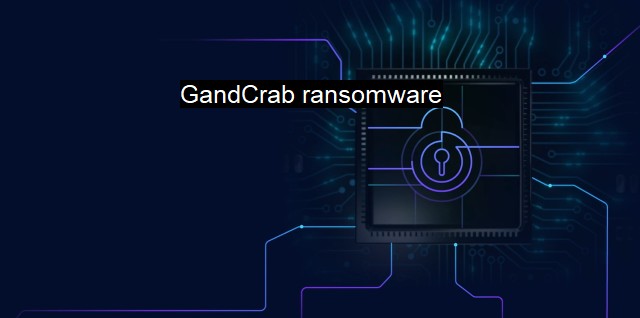What is GandCrab ransomware?
GandCrab Ransomware: A Pervasive Threat to Cybersecurity and Data Protection Across Various Sectors, Despite Improved Antivirus Solutions.
GandCrab ransomware is a malicious software designed to shut out users from accessing their own data and systems unless a ransom is paid. The ransomware gets its name from its creator (GandCrab), which propagates this software virally to innocent victims' devices through spam emails and malicious advertisements. This ransomware has caused significant turmoil in the digital world, prompting urgent action from cybersecurity experts and antivirus programs.Typically, once it infects a computer, GandCrab encrypts all files and displays a ransom message directing victims to pay in order to decrypt and regain access to their files. The ransom is generally demanded in digital cryptocurrency, such as Bitcoin or Dash, to maintain the anonymity of the authors and make any legal pursuit challenging, highlighting the sophistication of this criminal endeavor.
GandCrab, first identified in early 2018, rose rapidly in popularity to become one of the widespread ransomware strains, affecting countless personal and professional devices across the globe. It iterated through several versions, each time managing to surpass the decryption tools developed by cybersecurity experts. Thus, each upgrade essentially rendered prior protective countermeasures obsolete, leading to a continual race between the perpetrators and IT security professionals.
GandCrab employed a “Ransomware as a Service” (RaaS) model. This means that the GandCrab developers did not launch attacks personally. Instead, they offered their ransomware to other hackers under conditions that a fraction of the total ransom procured would be returned to the GandCrab authors. This Mass-distribution strategy amplified the extent of GandCrab's reach.
GandCrab primarily exploited security vulnerabilities within certain software, such as third-party applications, web browsers, or outdated Windows operating systems. It often lurked in illicit software activations (cracks), peer-to-peer networks, spam emails embedded with malicious macros, or infected websites waiting for an unsuspecting click.
In the cybersecurity context, GandCrab is a prime example of the cat-and-mouse game between hackers exploiting software vulnerabilities and security professionals seeking to patch them. The ransomware’s evolving nature made it a particularly formidable iteration of malware. Hence, cybersecurity experts recommended the deployment of dynamic antivirus software, equipped with state-of-the-art threat detection capabilities and automatic updates. One of the effective ways to counter this ransomware was frequent user-oriented training to avoid email attachments from unknown sources or refrain from downloading questionable software.
One key tool used in fighting the menace of GandCrab was decryption tools. Security companies collaborated to create decryption keys for different versions of GandCrab. It offered a significant blow to the GandCrab business model as victims could now get their data back without paying the ransom, thereby diminishing the ransomware's profitability.
Towards mid-2019, GandCrab virtually hung up its boots, citing retirement. While the truth remains uncertain, what was clear was a substantial decline in GandCrab attacks. Some experts speculated that this retreat had been timed to pre-empt legal pursuit, while others perceived it as making way for newly engineered strains of ransomware.
The legacy of GandCrab hovers as a stark warning of the substantial risks residing in the digital realm. The constant evolution of such threats necessitates a robust cybersecurity posture, underlining the immense importance of data backups, keeping systems up-to-date, and possessing an unrivaled antivirus suite. This approach not only provides a layer of protection against such disruptive cyber threats but also aids in the quick resonance in case of an unfortunate prevalence. The GandCrab episode is a reminder that prevention is always better than a post-incident cure.

GandCrab ransomware FAQs
What is GandCrab ransomware?
GandCrab is a type of ransomware that encrypts files on a victim's computer or network and demands payment in exchange for a decryption key. It was first discovered in early 2018 and has since become one of the most prevalent and damaging forms of ransomware.How does GandCrab ransomware infect systems?
GandCrab typically infects systems through phishing emails or malicious downloads. The malware can also exploit vulnerabilities in unpatched software to gain access to a system. Once on a system, it will start encrypting files and display a ransom note demanding payment to decrypt them.Can antivirus software protect against GandCrab ransomware?
Yes, most reputable antivirus software should be able to detect and block GandCrab ransomware before it can start encrypting files. However, it's important to keep your antivirus software up to date and to exercise caution when opening emails or downloading files from unknown sources.What should I do if my system is infected with GandCrab ransomware?
If your system is infected with GandCrab ransomware, do not pay the ransom as there is no guarantee that you will receive a decryption key. Instead, disconnect the infected system from the internet and contact a cybersecurity professional for assistance. Restoring from a backup is often the best way to recover your data after a ransomware attack.| | A | | | B | | | C | | | D | | | E | | | F | | | G | | | H | | | I | | | J | | | K | | | L | | | M | |
| | N | | | O | | | P | | | Q | | | R | | | S | | | T | | | U | | | V | | | W | | | X | | | Y | | | Z | |
| | 1 | | | 2 | | | 3 | | | 4 | | | 7 | | | 8 | | |||||||